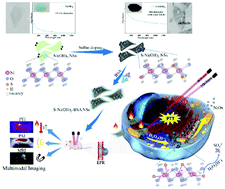Defect-engineered transition metal hydroxide nanosheets realizing tumor-microenvironment-responsive multimodal-imaging-guided NIR-II photothermal therapy†
Abstract
Exploiting two-dimensional nanomaterials as photo-based theranostic agents is promising for the highly efficient ablation of deep-tissue-buried tumors. However, they are limited by their poor absorption in the second near-infrared-light (NIR-II) bio-window (1000–1300 nm) and intrinsic nonbiodegradability. Herein, defect-rich sulfur-doped Ni(OH)2 (S-Ni(OH)2) nanosheets decorated with bovine serum albumin (BSA) as a novel theranostic agent is developed, which can accomplish multimodal-imaging-guided photothermal ablation of mouse cancers in the NIR-II bio-window. Sulfur doping extends the absorption spectra of Ni(OH)2 nanosheets from the visible to NIR-II bio-window, affording highly efficient photothermal conversion (58.20% for 1064 nm), entailing it to become an excellent contrast agent for photoacoustic imaging. Further, because of their intrinsic paramagnetic property, they can be applied for magnetic resonance imaging. Owing to the abundant defective sites in S-Ni(OH)2 nanosheets, they exhibit response to the tumor microenvironment, resulting in effective biodegradation and excretion from the body. In vivo toxicity experiments indicated that S-Ni(OH)2-BSA NSs delivered no appreciable toxicity and good biocompatibility. This work provides an avenue for the rational design of effective theranostics agents.



 Please wait while we load your content...
Please wait while we load your content...